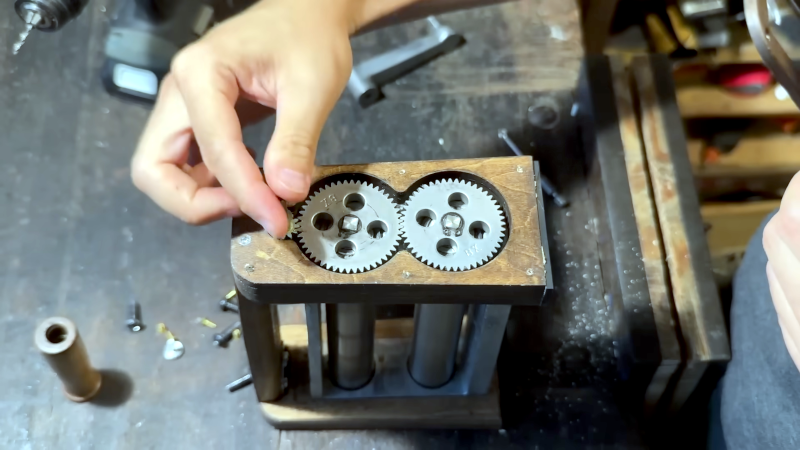[Kevin Cheung] likes to upcycle old soda cans into — well — things. The metal is thin enough to cut by hand, but he’d started using a manual die-cutting machine, and it worked well. The problem? The machine was big and heavy, weighing well over 30 pounds. The solution was to get a lightweight die cutter. It worked better than expected, but [Kevin] really wanted it to be more portable, so he stripped it down and built the mechanism into a new case.
The video below isn’t quite a “how-to” video, but if you like watching someone handcraft something with a lot of skill, you’ll enjoy it. It also might give you ideas about how you could use one of these cutters, even if you don’t bother building a nice case for it.
We’ve seen cutters that use computer control, but they aren’t inexpensive. They will, however, make the same kind of cuts. But these manual die cutters are very inexpensive, and you simply have to find a way to make the die. You can easily make them for cutting paper, and, with the right materials, you can make the kind you see in [Kevin]’s video, too.
We have to admit, carrying the gizmo into a public place seemed to make a lot of people happy. So maybe portability is a good goal. But either way, you can have some fun with a machine like that.
If you want to cut paper, these work great. If you want paper to make the cuts, we have just the thing for you.
















Flashback! When I was a small child, there were cheap cheap toys of many kinds, made from thin sheet metal. These came from Japan or Hong Kong. If you took them apart, you would see that they had been made from steel soft drink or beer cans (this was before aluminum beverage cans).
But this is fantastic. I have wondered whether dies made by chem milling could work for cutting thin materials, and this is the answer!
How do you make a DIY press die, the etched version?
That is indeed the question I was asking myself too, without the die, a die-press is useless.
So I expect a followup video where that part is explained, considering that this video was a follow-up video to the can cutter project.
It looked like he could order them very inexpensively.
I’d also like to see if a pasta press would work 😆
Brilliant. The mobility of the solution and how the craft touches people is amazing.
I noticed that he used wood to build the new frame instead of 3D printing the parts. I don’t know if this is to keep with a more “green” theme, but there is a certain appeal and charm to wood and metal (vs. plastics).
Metals embody the notion of strength, durability and precision, while (real, properly coated) wood implies craftsmanship.
Plastic is neither strong nor precise, nor durable, and with the marks of 3D printing on it reminds you that it didn’t require any skill or effort to manufacture. No matter how well made, it just looks fake.
It’s kinda like those jewelry boxes that are put together with hot glue out of laser-cut particle board and then painted hastily in white chalk to give it that “rustic” look. It’s not convincing anyone that it is an antique box with a naturally perishing paintwork because it’s made of shredded and compressed cardboard.
Saying that plastic isn’t strong, precise, or durable is just plain incorrect and it shows that you don’t have a lot of manufacturing knowledge.
Some plastics may be, with suitable fillers and additives, but your typical 3D printed or consumer grade injection molded object isn’t that.
The point was about what impression the object gives to the viewer, and with plastics you get the sense of low quality because that’s what most plastic objects are.
I love his can-do attitude
Awesome what a great way to recycle,! Bravo!
Jieli UPVC products stand out in the building industry for their durability, cost-effectiveness, and versatility, particularly in roofing and wall cladding. Unlike traditional materials like metal, clay, and concrete, Jieli UPVC roofing sheets offer superior weather resistance, not rusting or corroding in harsh environments. Their unplasticized composition ensures longevity, while UV inhibitors prevent sun damage, preserving their aesthetic appeal over time.
In addition to being lightweight, which simplifies handling and installation, Jieli UPVC provides excellent thermal insulation, reducing energy costs in both hot and cold climates. The material is also fire-resistant, self-extinguishing once the flame source is removed, and it resists a wide range of chemicals, making it suitable for industrial and agricultural applications.
Jieli’s commitment to quality and innovation is reflected in their robust product design and ongoing research and development. While the initial cost of UPVC may be higher than traditional materials, its long lifespan and low maintenance make it a cost-effective choice in the long term. Additionally, its aesthetic versatility allows for a wide range of designs. Jieli UPVC products are a reliable and environmentally friendly solution for various building needs.“http://jlrooftile.com”